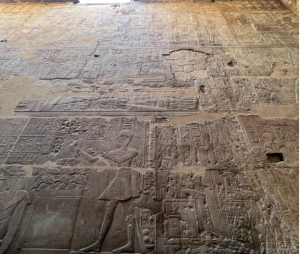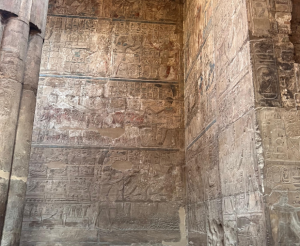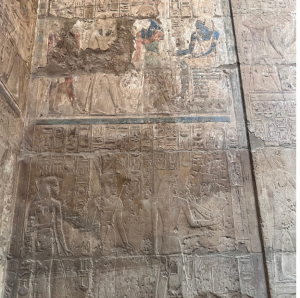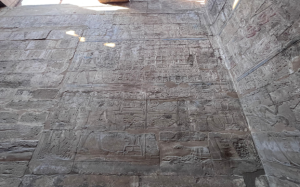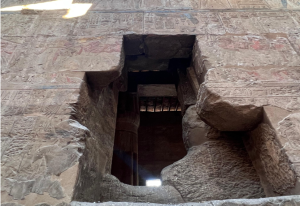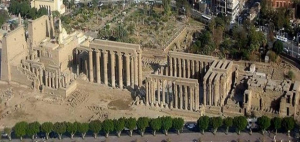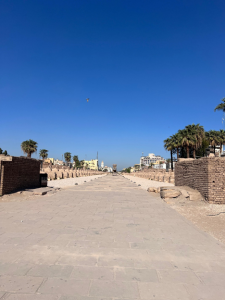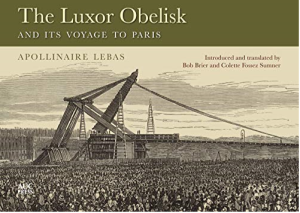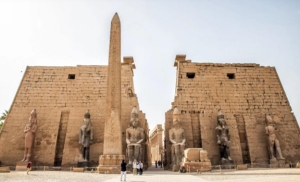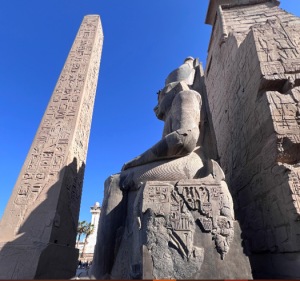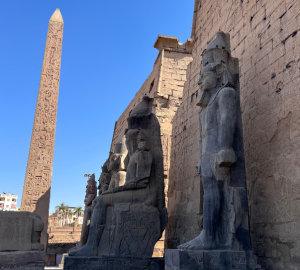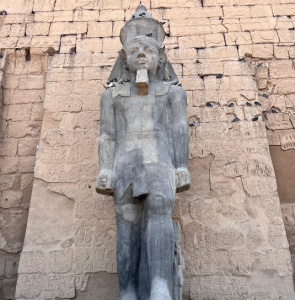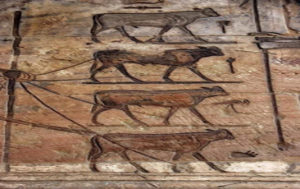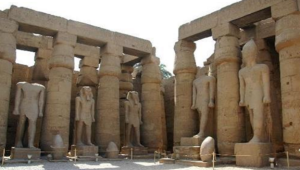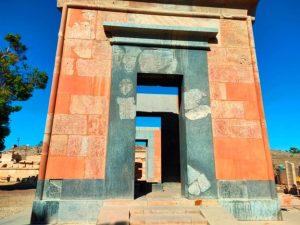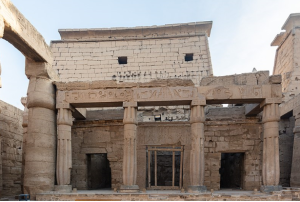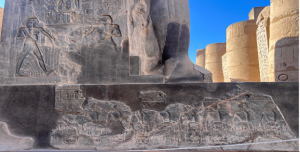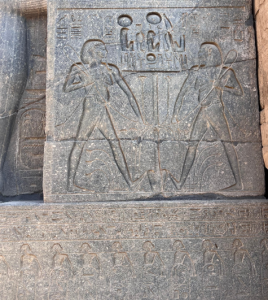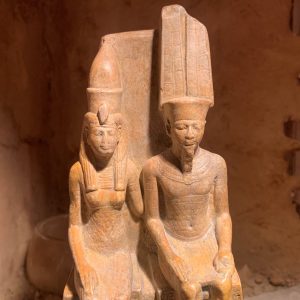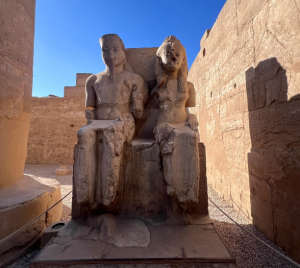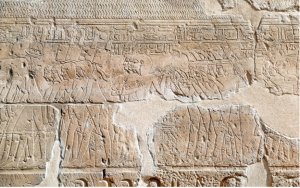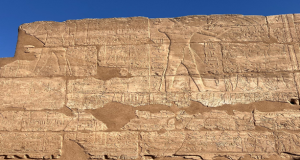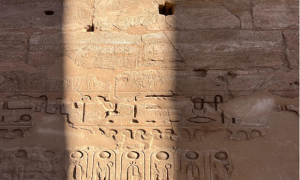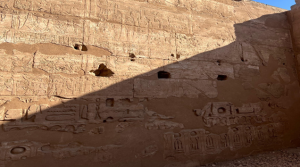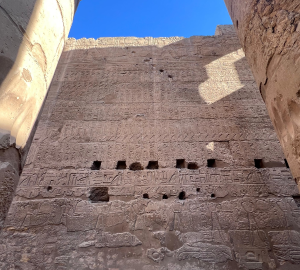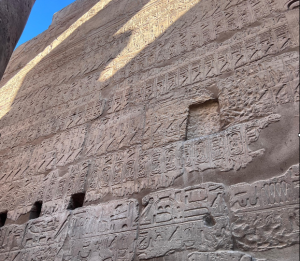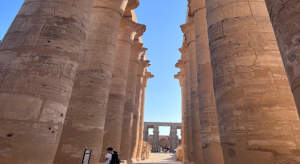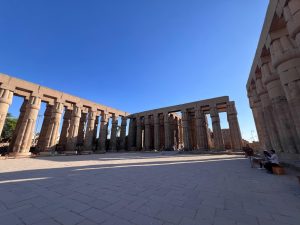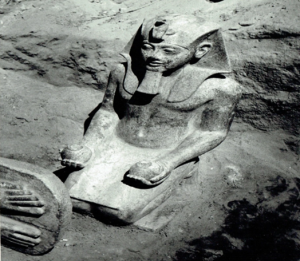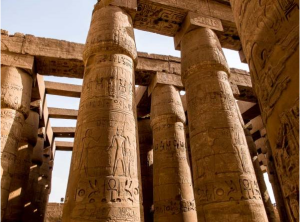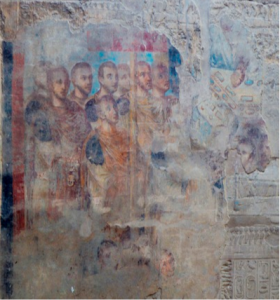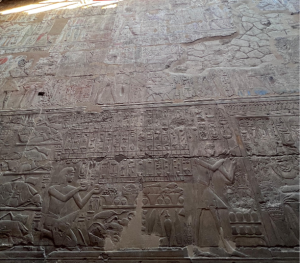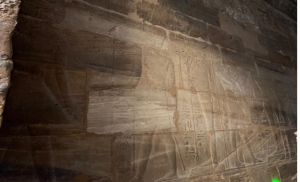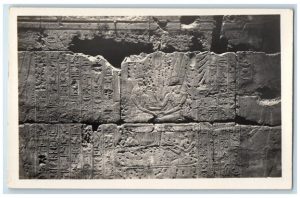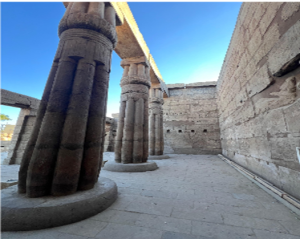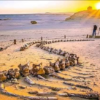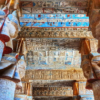Thebes
Thebes was called “Waset”, meaning “scepter,” and was the capital of the fourth region of Upper Egypt. In the Greek era, it was called “Thebes,” a comparison to a Greek city called “Thebes.” The Arabs called it “Al-Qasr,” meaning “the city of palaces,” because they believed that every temple was an old pharaonic palace. It was called also, the “city of a hundred gates” because of the many large buildings in it. Thebes is considered the richest Egyptian capital throughout history, and indeed, the richest capital in the ancient world. Interest in Thebes began in the Middle Kingdom under King Mentuhotep II, who made it his capital and began construction there, building his temple at Deir el-Bahri in the west. Senusret I also built a white shrine of marble that existed in the Karnak Temple. In the New Kingdom, Thebes became the capital of the Egyptian Empire. Temples of the gods were built on the east bank, and temples to commemorate pharaohs were built on the west bank, such as the Temple of Habu, the Ramesseum, and the Temple of Hatshepsut. They also built eternal tombs on the west bank, most notably the Valley of the Kings, the Valley of the Queens, and the Tombs of the Nobles. They also established a city for the workers who built the temples and tombs on the west bank, called “Deir el-Medina.”
The Temple of Luxor
Located on the east bank of the city of Thebes, its orientation is north-south, parallel to the Nile River, unlike the Temple of Karnak which is oriented from east to west like the rising and setting of the sun.
Name of the Temple
The temple is called “Ipet-resyt,” meaning “the southern shrine,” referring to the dwelling place of the goddess “Mut,” the wife of the god “Amun-Ra. The temple was dedicated to the worship of the god “Amun-Ra,” his wife “Mut,” and their son “Khonsu.
Construction of the Temple
The architect Amenhotep, son of Hapu, designed the temple during the reign of Amenhotep III. He constructed the inner part of the temple (the holy of holies) and the second open courtyard, with a columned hall between them. King Ramses II completed the remaining parts of the temple, including the outer facade, and erected two obelisks in front of it.
Reason for Construction
It seems that King Amenhotep III was not the legitimate heir to the throne after his father Thutmose IV. So, the priests created a divine birth story for him, claiming he was the son of the god “Amun-Ra.” Thus, he became entitled to sit on the throne of the god. the avenue of the Sphinx in front of the temple that connects it to the Avenue of the Sphinxes and the Karnak Temple, was erected by King Nectanebo I of the 30th dynasty in 342 BC. In 1870, the French scholar Mariette cleared the debris from the statues of Ramses II.
Layout of the Temple
1. Avenue of the Sphinx 2. Shrine of Isis 3. The temple’s facade with obelisk of Ramses II and six of his statues 4. An open court of Ramses II consisting of 74 columns 5. Shrines of Hatshepsut and Thutmose III 6. A hypostyle hall with 14 columns from the reign of Amenhotep III 7. an open festival court of Amenhotep III with 64 columns 8. hall of 32 columns 9. Remains of a basilica 10. Hall of offerings 11. Chamber of the divine birth 12. Hall of 12 columns 13. Shrine of Alexander the Great 14. Holy of holies
The Avenue of the Sphinxes
Dating back to the era of King Nectanebo I of the 30th dynasty, it connected the Temple of Karnak to the Avenue of the Sphinxes which, in turn, connected to the Karnak Temple. There are approximately 70 sandstone statues on the Avenue of the Sphinxes.
Importance of the Avenue of the Sphinxes
The procession of the god Amun during the Opet festival would come via the Nile River and return via the Avenue of the Sphinxes, then to the Avenue of the Sphinxes to the Karnak Temple. One of the most beautiful discoveries from the excavations was that around the Avenue of the Sphinxes, there were places like cafes and shops where people would celebrate the return of the god from the Temple of Luxor to the Karnak Temple.
A picture shows the beginning of the Avenue of the Sphinxes, dating back to the reign of King Nectanebo I of the 30th dynasty. It used to reach the Temple of Khonsu. This avenue replaced the Avenue of the Sphinxes which dates back to the reign of King Amenhotep III.
A picture shows a statue of the sphinxes belonging to King Nectanebo I. The area was developed in 2021 during the celebration of the Avenue of the Sphinxes, in the presence of the President.
Shrine of Isis
A shrine located on the southwest side of the Avenue of the Sphinxes. It contains a statue of the goddess Isis and was built in the Roman era. It is constructed of mud bricks.
Obelisks of the Temple of Luxor
King Ramses II erected two pink granite obelisks in front of the temple. The eastern obelisk remains in front of the temple, with a height of 22.5 meters from the base. The base has a height of 2.5 meters and weighs 257 tons. At the sunrise of the god “Amun-Ra,” the base is decorated with baboons howling. The western obelisk is now located in the Place de la Concorde in Paris. Reason for transferring the obelisk from Karnak to Paris: After Champollion deciphered the Rosetta Stone in 1822 and visited Luxor, he stayed in one of the tombs in the Valley of the Kings. He sent a message to the French King Philippe Louis saying, “If you want to adorn Paris with the most beautiful obelisk from the ancient world, ask the viceroy Muhammad Ali for one of the obelisks of the Temple of Luxor.” Muhammad Ali had relied on the French in forming his army and establishing gunpowder factories in Egypt. When King Philippe Louis asked him for the obelisk, he gifted him an hourglass, which was the first of its kind in Egypt. Muhammad Ali had accepted it , and it still exists in the Citadel of Salah al-Din in Cairo, next to the Mosque of Muhammad Ali. So, Muhammad Ali agreed to transfer the obelisk to Paris. And now, it has become an ambassador for Egypt in the heart of France.
A picture shows the celebrations of the French upon the arrival of the obelisk in the de la Concorde in France.
Reason for erecting obelisks in front of temples:
Because they were covered with a layer of electrum, which are thin sheets of gold that covered the top of the obelisks, making them more radiant during the day and luminous at night. So, they became like an announcement of the existence of the temple.
Picture of the Eastern Obelisk located in the Luxor Temple
1-The Temple’s Facade
It is a large pylon divided into two parts, an eastern and a western part, representing the eastern and western mountains that surround the Nile River in the geography of Egypt. The pylon is 65 meters long and 24 meters high. King Ramses II built it and inscribed on it the details of his most important battle, “the Battle of Kadesh.” The most important scenes from the western side show him sitting with his advisors, then a scene of him inside his war chariot. On the eastern wall, there are scenes of the king inside his chariot shooting arrows at enemies, the ground covered with the dead and wounded, and enemy soldiers fleeing in terror. In one scene, we find the prince of Kadesh frightened in his chariot. There are 4 openings in the pylon, two on each side with vertical cavities, to place flags in front of the temple. The eastern pylon is also inscribed with King Ramses and his wife Nefertari celebrating the god Min, the god of fertility. In front of the pylon are 6 statues of King Ramses II, 3 on each side. The two statues on either side of the entrance represent King Ramses II seated and are made of black granite. Next to the statue on the eastern side, we find Queen Nefertari, while in the western statue, we find their daughter Merit-Amon. As for the standing statues of Ramses II, they are 14 meters tall and were restored in 2023.
A picture of the positions of the statues of King Ramses II in front of the Western Obelisk, which is the facade of the temple
A picture of the statue of Ramesses II sitting with the obelisk in front of him
A picture showing the four statues of Ramesses II with the temple edifice and the eastern obelisk in front of them
King Ramesses II
The First Open Courtyard
It consists of 74 columns in the shape of a closed papyrus flower. Between them are 8 statues of King Ramses II standing and two seated. As a result of the existence of the shrines of Queen Hatshepsut and King Thutmose III in the open courtyard on the western side, the axis of the temple deviated slightly towards the east. This courtyard was dedicated to celebrating the Opet festival (the marriage of the god Amun-Ra to his wife, the goddess Mut). It was an open courtyard because it allowed the general public to enter. The rich would offer sacrifices, and the poor would eat from them.
A picture showing four bulls being taken as an offering to the god Amun-Ra
the open courtyard
Shrines of Hatshepsut and Thutmose III:
There were 3 shrines dedicated in the middle to the god Amun, which is the largest shrine. On the eastern side, there is a shrine for his wife, the goddess Mut, and on the western side, there is a shrine for their son Khonsu. These shrines are preceded by four red granite columns with papyrus capitals and are located in the northwestern part of the courtyard. In the northeastern part, there is the “Abu al-Haggag Mosque” which was built in the Fatimid era on the ruins of a church that was built in this place in the third century AD. This means that this courtyard contains three different civilizations for the first time in one courtyard: Pharaonic, Christian, and Islamic.
Queen Hatshepsut’s shrine
A picture showing the three shrines Each one was characterized by scenes representing the burn of incense, purification, and the offering of fats and offerings to the sacred boat, in addition to various religious scenes
Abu al-Haggag Mosque, in front of which is a seated statue of Ramesses II
Wall sculpture of the god Amun with King Ramesses II
And there are two entrances, from the western and eastern sides, for the priests carrying the processions of the gods. There are many scenes in this courtyard, the most important of which are the scenes of offering sacrifices and scenes of the peoples whom King has been defeated by Ramses II. On the southern wall, from the western side, is represented the facade of the Luxor Temple with its pylon, obelisks, and the cow statues. On the heads of these statues are depictions of Egypt’s enemies in the form of human heads.
An image depicting the inscriptions of the statue of Ramses II in the first courtyard of the Luxor Temple shows the details of the nine enemies of Egypt, who are subdued under the feet of the king. Above, the Nile god, Hapi, is shown connecting Upper and Lower Egypt (Sematawy).
image of the god Hapi engraved on the side of the throne of the statue of King Ramesses II depicts the god Hapi when he united the two countries “Sematawy”, where he connects the papyrus and lotus plants
The Hypostyle Hall
The hypostyle hall consists of 14 columns in the shape of an open papyrus flower, distributed as 7 columns on each side. Each column is 16 meters high. It was built in the reign of King Thutmose III and completed in the reign of Kings Tutankhamun and Horemheb. On its western and eastern walls, there are scenes depicting the celebration of the Opet festival. In the hall, there is a beautiful double statue of limestone of the god Amun and his wife Mut. There is also a statue of Tutankhamun and his wife.
God Amun and His wife Mut
A statue of Tutankhamun and his wife “Ankh esen Amun”, daughter of Akhenaten and Nefertiti, from the ruins of the first courtyard of Luxor Temple
The most important scenes of the Opet Festival journey
On the western wall, starting from the north to the south: On the eastern wall, the scenes start from the south to the north. The scenes on the western wall represent the journey of the god Amun from Karnak to Luxor Temple to visit his wife, in addition to scenes of the celebrations inside the temple.
The most important scenes on the western wall
1. The royal offerings presented to the sacred triad’s barques inside the Karnak Temple. 2. The priests carrying the gods’ barques from the Karnak Temple to the harbor in front of the temple, which is connected to a canal linking Karnak Temple to the Nile River. 3. The divine barques sailing on the surface of the Nile River towards Luxor Temple. 4. the barques upon their arrival at Luxor Temple. 5. the priests entering the barques into Luxor Temple. 6. the sacred barques inside the temple, being offered sacrifices.
As for the eastern side
1. The scenes begin with the barques exiting the holy of holies to Luxor Temple, carried by the priests, and then royal offerings are presented to them inside the temple. 2. The barques being carried on the shoulders of the priests from Luxor Temple to the Nile. 3. The procession of barques sailing on the Nile towards Karnak. 4. Scenes of the sacred barques upon their arrival at Karnak Temple. 5. The barques inside Karnak Temple.
The Column in Ancient Egyptian Thought
The column represents plants and trees. At its base is a round-shaped base that represents the seeds of the plant. The body of the column represents the stem of the plant, and the column’s capital represents the flower. If the column’s capital is open, it means that sunlight is falling on it. If it is closed, it means that it is away from the sunlight. Columns with an open papyrus flower represent the departure of the gods’ boats to the marshes of the delta. Here in the temple, it means that the procession of the god exits the Holy of Holies, then the priests carry it in the hall of columns for sunlight to fall upon it and illuminate the procession so that the people in the open courtyard can see it (and here the people begin to cheer, and the celebrations of the gods’ festivals begin).
The Method of Building Columns
The first course of the walls and the bases of the columns is built, and the area around them is filled with Nile mud. Then, bridges of mud bricks are erected around the walls. As for the stones, they are placed using the technique of the platform, meaning they are placed side by side to make it easier to position and place the stones. When the second course is built to protect it, the height of the mud around the columns is increased, and bridges are hung around the structure. And so on until the construction reaches the end of the column and it is erected. After that, the bridges are removed, and the mud is removed from around the column. Manifestations of the Opet Festival as Depicted in the Following Images:
A picture of the ancient Egyptians celebrating Opet Day
The columns of the Corridor of the Masters and end with a blooming lotus flower
The Open Courtyard
The second celebration courtyard of Amenhotep III is an open courtyard with 64 columns. Festivals, especially the Opet Festival during the reign of Amenhotep III, were held here. The columns are in the shape of papyrus stems.
Columns of the open courtyard at the Luxor Temple
A depiction of Amenhotep III offering sacrifices from the scenes of the great courtyard
The Luxor Temple Cache
In 1988 AD, because the groundwater was affecting the columns, the Egyptian government decided to dismantle them. During this process, they accidentally discovered the temple’s cache on January 22, 1989. The cache contained 26 statues from the reign of King Amenhotep III during the New Kingdom until the reign of King Shoshenq in the Late Period. All the statues were either royal or divine. This cache has been preserved in the Luxor Museum in a hall called “The Cache Hall
One of the statues from the Luxor Temple cache
The Luxor Temple cache
The Luxor Temple cache dates back to the New Kingdom era
Hall of the First Columns (Hall of Illumination)
It is a hall with 32 columns. There is a small vestibule in it with 8 columns. They were removed in the Roman era and replaced with a temple for the Roman emperors. It is called the Hall of Illumination because the god Amun would illuminate it when he emerged from the Holy of Holies. Most of the hall’s scenes are damaged, and there is a scene depicting the unification of different lands. Another scene shows King Amenhotep III in front of the Theban triad: Amun, Mut, and Khonsu.
Image showing the columns of the Hall of Illumination
Greek inscriptions are found in the Hall of Illumination.
Decorations of the great columned hall in the Hall of Illumination
In the Roman Era
all columns have been removed and transformed the temple into a Roman temple, then into a Christian church. They covered the images of King Amenhotep III with a white layer and transformed the entrance into an apse flanked by two columns of the Roman Corinthian style. We find a very beautiful scene on the eastern side of the hall representing the 12 disciples of Christ in what is known as the scene of “The Last Supper”.
Image of the apse and the two Corinthian-style columns (Roman-style arrangement)
Image on the walls of the Byzantine church representing the disciples of Jesus Christ”
Offering Hall
It is a hall with four columns in two rows that the sacred procession of the god Amun passed through when entering or exiting the Holy of Holies. All the hall’s engravings are dedicated to offerings, and on the eastern side, we find a scene of the king leading four oxen to be slaughtered in celebration of the Opet Festival.
A scene from the Offering Hall depicts the king presenting offerings to the god Amun-Ra. Above, a procession of the king is shown leading four oxen to be sacrificed during the festivals. Below, the king is kneeling before Amun-Ra with the oxen already slaughtered behind him
Alexander the Great’s Chamber
It was a square hall containing 4 columns. Alexander the Great removed them and built a chamber in their place named after him, also called the chamber of the sacred boat. There are 40 different scenes on its walls depicting the king with various gods.
Alexander the Great’s Chamber
Purification Chamber
A rectangular room with 3 columns. It is reached from the eastern wall of the offering hall, and its scenes depict the king’s washing and purification before the beginning of the celebrations.
Image showing the process of purifying the god with water for the king
Divine Birth Chamber
We reach it from the northern wall of the purification chamber. It has three columns with papyrus bud capitals. This chamber is the reason for building the temple. King Amenhotep III was born to a foreign mother named Mut-em-wia, so he did not have the right to sit on the throne. The priests invented for him a story of divine birth, just as they had done for Queen Hatshepsut before him. The scenes depicting the divine birth are depicted on the western wall of the chamber from bottom to top. The scenes depict the god Amun-Ra entering the chamber of Queen Mutemwiya, appearing in the form of her husband Thutmose IV, then sitting in front of her on the throne and giving her the key of life before her nose (meaning he grants her the life of the child Amenhotep III). Here, he revealed his sacred form to her. Then we see the god Amun-Ra ordering the god Khnum (the creator god) in the form of a man with a ram’s head to take the child and his ka on the potter’s wheel. Then we find a scene of the goddess Hathor protecting the mother and child. Then we find a scene in the middle where the god Khnum tells the queen that she is pregnant. we see her going to the birth chamber accompanied by Khnum and Hathor. we see her sitting on a birthing chair (they used to give birth while sitting, not on a bed), and her mother, the goddesses who protect the child, including Hathor, Taweret, and the god Bes (the god of happiness), are waiting to receive the child soon. After the queen gives birth to the child, we see the goddess Hathor holding him in her hands in front of the god Amun-Ra, who blesses him and gives him a long and happy life. As for the upper scenes, we see Hathor returning the child to the goddess of motherhood, then other images of the child growing up in front of the gods until we finally see him ascending the throne of Egypt. We notice that the Egyptians believed that the gods mated while sitting on the throne, and they also believed that the key of life is what gives the child a soul in his mother’s womb. In this way, Amenhotep III became not only the son of his father but also the son of the god Amun-Ra and thus acquired the legitimacy to rule
god Amun-Ra giving the key and the breath of life to the mother of Amenhotep III to carry him (divine birth)
Hall of the Sun
It consists of three chambers: an eastern chamber, a western chamber, and a central longitudinal hall. The central hall has 12 columns with papyrus bud capitals, and it has a unique style called the basilican style, where the central part is higher than the sides to allow sunlight and air to enter. There are scenes related to fertility and scenes related to the cycle of the sun, 12 hours for the day and 12 hours for the night. There are also scenes of the sun’s scenes on the walls.”
The Holy of Holies
It is considered the first and most important part built in the Luxor Temple. It consists of three chambers, with a central chamber containing four columns. Inside, there are scenes of King Amenhotep III with the Theban Triad (Amun, Mut, and Khonsu). It is dedicated to the god Amun. It is accessed through an entrance in the southern wall of the Hall of the Sun. This entrance is decorated with scenes of the Nile god Hapi offering sacrifices to the gods, symbolizing the abundance brought by the Nile’s flood. Around the Holy of Holies are chambers for the daily service rituals.
Scenes depicting the Holy of Holies on the temple walls:
